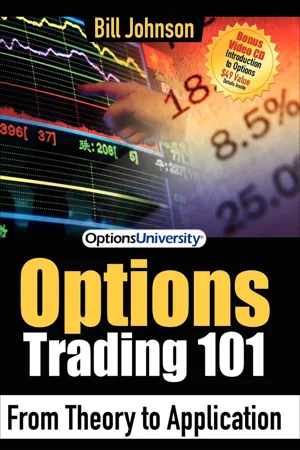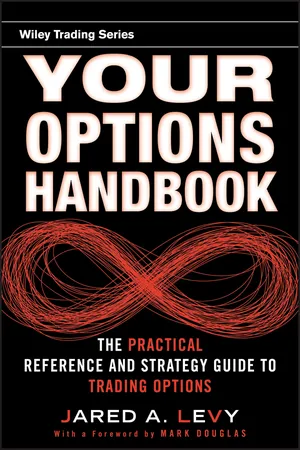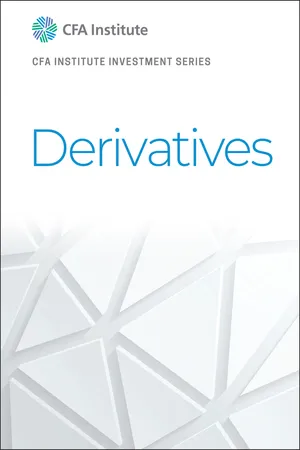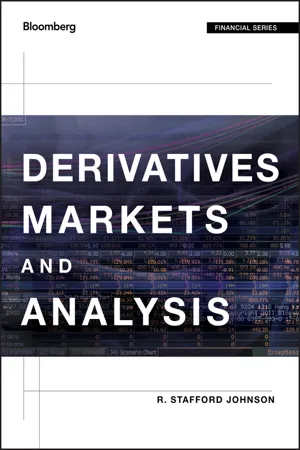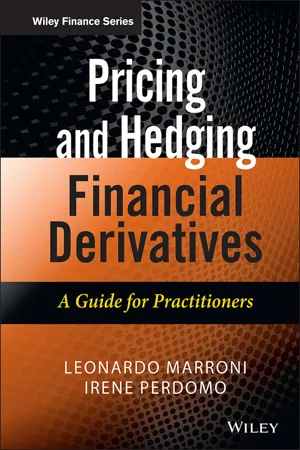Business
Put Call Parity
Put-call parity is a principle in options pricing that establishes the relationship between the prices of call and put options with the same strike price and expiration date. It states that the difference between the call and put option prices should be equal to the difference between the current stock price and the present value of the strike price. This concept helps in understanding and valuing options.
Written by Perlego with AI-assistance
Related key terms
1 of 5
8 Key excerpts on "Put Call Parity"
- eBook - ePub
Options Trading 101
From Theory to Application
- Bill Johnson(Author)
- 2020(Publication Date)
- Morgan James Publishing(Publisher)
Chapter Five Put-Call Parity and Synthetic Options Up to this point, calls and puts appear to be polar opposites. Calls represent the right to buy while puts represent the right to sell. And if you look at option quotes, there doesn’t appear to be any connection between the price of the call and the same-strike put. However, call and put prices are highly dependent and are not arbitrarily chosen. Although it may not appear possible, there is a strong, mathematical relationship that describes the connection between calls and puts known as put-call parity. This is one of the most important concepts for beginning and advanced option traders alike, so we will devote an entire chapter to it. Once you understand put-call parity, you’ll find that calls and puts are really one in the same; it just depends on how they’re paired with the underlying stock. So, strange as it may sound, calls are really puts and puts are really calls if properly paired with the underlying stock. In fact, when options were first introduced in 1973, only call options were traded on 16 stocks. Put options did not appear until 1977. The reason is that puts were created by “put-call brokers” who created puts by properly pairing calls with the underlying stock and put-call parity show them how to do just that. The word “parity” means “equivalence.” There are many types of parity relationships in the financial world such as purchasing power parity and interest rate parity, for example. Parity relationships simply show the connections between two or more variables. As stated before, put-call parity just shows that calls and puts are “equivalent” when properly paired with the underlying stock. Once you understand put-call parity, you will have increased insights into the mechanics of the options market and how options are priced - eBook - PDF
The Mathematics of Options
Quantifying Derivative Price, Payoff, Probability, and Risk
- Michael C. Thomsett(Author)
- 2017(Publication Date)
- Palgrave Macmillan(Publisher)
Put/Call Parity In options trading, put/call parity has two definitions. First, it can be used to describe the similarity in the bid/ask spread and the net debit or credit set up for any options trade employing different options with the same strike. This may refer to a combination of calls and puts, long and short, or both. The concept of put/call parity was introduced by Hans Stoll in 1969. In his paper, Stoll observed that “… relative put and call prices are closely related regardless of stock price movements or expectations about future movements.” 2 Varying premium values between calls and puts are commonplace. This is true whether the strike as at the money or close to it. Whenever the premium values are identical, they are at parity. The value of put/call parity applies in the use of specific strategies, notably for synthetic long or short stock or straddles. In these strategies, the existence of parity at the money is desirable. For example, the synthetic stock strategy includes the purchase of a call and the sale of a put at the same strike (synthetic long stock), or the purchase of a put and the same of a call (synthetic short stock). A synthetic is so called because the combined option positions mirror price movement in the under- lying point for point. At parity, the only cost should be trading fees, due to parity between the long and short option. The same observation applies to 3 Pricing of the Option 57 straddles, in which a long call and long put are opened at the same strike (long straddle); or a short call and short put are opened at the same price. Because bid and ask prices often vary considerably between different stocks, parity is not always available. The use of strategies with different options at the same at-the-money strike may involve a small credit or debit adjustment. - eBook - ePub
The Options Edge
An Intuitive Approach to Generating Consistent Profits for the Novice to the Experienced Practitioner
- Michael C. Khouw, Mark W. Guthner(Authors)
- 2016(Publication Date)
- Wiley(Publisher)
Put–call parity defines the relationship between the prices of a European call, a European put, the underlying security, and the risk-free asset. For this relationship to hold, the strike price and the time to expiration of the put and the call must be identical. In addition, the risk-free asset that is typically defined as a U.S. Treasury bill must have the same maturity date as the expiration date of the two options. In the case of equity securities, the equation for put–call parity is defined below. Put–call parity does not just apply to stocks and their related options. It governs the relationship between the price of any asset and its associated options.The intuition behind this equation should be very clear. The left-hand side of the equation describes a stock with a married put having the same payoff pattern as holding cash plus a call option. Given this identity, if the price of the stock rises by the expiration date of the put, the investor can sell the stock for a gain while the put expires worthless. If the price of the stock falls below the strike price of the put option, the investor can exercise her right and sell the stock to the put writer at the agreed upon strike price. This will minimize investor loss, which is equal to the starting stock price less the option's strike price less the premium paid on the put option.The right-hand side of the equation is another way of describing the same payoff pattern. Instead of buying stock and a married put, the investor buys a call option, keeping the rest of her assets in credit and interest rate risk-free cash equivalents. If the price of the underlying stock is above the strike price by expiration, the investor exercises the call and sells the stock purchased for a gain. If, on the other hand, the price of the stock falls, the call expires worthless, leaving the investor with cash. All that is lost in this scenario is the option premium on the call.The beauty of put–call parity lies in its simplicity, requirement for minimal assumptions, and ease of implementation. Put–call parity allows for the static replication of any of its four elements. In addition, with the assumption that traders can freely borrow and lend at the same rate, cash on hand is not necessary to structure a trade. In theory, borrowing funds for the term of the options can finance the underlying asset and the relationships still holds. Furthermore, it does not require the existence of a forward contract, although one can be created synthetically. In addition, put–call parity presents the relationship of static replication. In a static replication, the reference asset and the replicating portfolio have the same cash flows. By contrast, dynamic replication does not have the same cash flows as the reference asset. A good example of dynamic replicating is gamma scalping. The payoff pattern of a call option is created dynamically by purchasing the underlying asset as its price rises and selling it as its price falls. The end result is a payoff pattern that looks identical to the final payoff pattern of a call option, but the cash flows are different. - eBook - ePub
Your Options Handbook
The Practical Reference and Strategy Guide to Trading Options
- Jared Levy(Author)
- 2011(Publication Date)
- Wiley(Publisher)
In the synthetics section, you learned how we can create a synthetic long or short stock position using options. Usually there are only minor differences in the cost of creating a synthetic versus just going out and buying the stock (other than commissions, of course). The reason for this is put-call parity, which is the natural three-sided relationship between a call and put and the underlying instrument (stock, etc.).Here are the three characteristics that are referred to as put-call parity:1. Underlying price = call price – put price + exercise price.2. Put price = call price – underlying price + exercise price.3. Call price = underlying price + put price – exercise price.Trader TipCheck out some options chains after the market closes and see if you can prove put-call parity. Just be sure that your stock is not hard to borrow—that will make the put more expensive and thus put-call parity may cease to exist.If the time value for the put is different from the call, there will be a difference in the synthetic position compared to a real stock position, making the synthetic either too cheap or too expensive.By the way, if these concepts make absolutely no sense to you, don’t worry; understanding put-call parity and synthetics in gross detail is not a prerequisite to making money with options. Furthermore, in today’s extremely efficient markets, this knowledge will have minimal benefit to you as a retail trader.Using Options to Lend or Borrow MoneyOptions can be used to borrow and lend money; for example, what if you bought a nondividend-paying stock at a specific price from a person who needed to borrow money from you (there is the initial loan collateral)? Then you synthetically created a short stock position using a short call and long put that expire two years in the and make the borrower take the other side of the trade, meaning she has to buy a call and sell a put, and for a fee, which you set (your interest payment). In this example, you have essentially created a direction-neutral (100% hedged) position in that stock. - eBook - PDF
- (Author)
- 2021(Publication Date)
- Wiley(Publisher)
Arbi-trage opportunities like this, however, will be noticed by many investors who will engage in the same transactions. Prices will adjust until parity is restored, whereby S 0 + p 0 = c 0 + X /(1 + r ) T . Put–call parity provides tremendous insights into option pricing. Recall that we proved that going long the asset and long a put is equivalent to going long a call and long a risk-free bond. We can rearrange the put–call parity equation in the following ways: S 0 + p 0 = c 0 + X ⁄ ( 1 + r ) T ⇒ p 0 = c 0 − S 0 + X ⁄ ( 1 + r ) T c 0 = p 0 + S 0 − X ⁄ ( 1 + r ) T S 0 = c 0 − p 0 + X ⁄ ( 1 + r ) T X ⁄ ( 1 + r ) T = S 0 + p 0 − c 0 By using the symbols and the signs in these versions of put–call parity, we can see several important interpretations. In the equations below, plus signs mean long and minus signs mean short: p 0 = c 0 − S 0 + X ⁄ ( 1 + r ) T ⇒ long put = long call, short asset, long bond c 0 = p 0 + S 0 − X ⁄ ( 1 + r ) T ⇒ long call = long put, long asset, short bond S 0 = c 0 − p 0 + X ⁄ ( 1 + r ) T ⇒ long asset = long call, short put, long bond X ⁄ ( 1 + r ) T = S 0 + p 0 − c 0 ⇒ long bond = long asset, long put, short call Chapter 2 Basics of Derivative Pricing and Valuation 101 You should be able to convince yourself of any of these points by constructing a table similar to Exhibit 15. 20 10.1. Put–Call–Forward Parity Recall that we demonstrated that one could create a risk-free position by going long the asset and selling a forward contract. 21 It follows that one can synthetically create a position in the asset by going long a forward contract and long a risk-free bond. Recall our put–call parity discussion and assume that Investor A creates his protective put in a slightly different manner. Instead of buying the asset, he buys a forward contract and a risk-free bond in which the face value is the forward price. Exhibit 17 shows that this strategy is a synthetic protective put. - eBook - ePub
- R. Stafford Johnson(Author)
- 2017(Publication Date)
- Bloomberg Press(Publisher)
fiduciary call, and it can be used as a substitute for buying the stock and put.The equality between the stock‐put portfolio and the bond‐call portfolio may be expressed algebraically as:This expression is commonly referred to as put‐call parity. Since the two portfolios have exactly the same cash flows at expiration, their values at any time t must be identical, or else arbitrage opportunities will exist. For example, if the bond‐call combination is cheaper than the stock‐put portfolio, an arbitrageur can earn a profit without taking risk and without investing any of her own money. To expedite the strategy, the arbitrageur would have to buy the cheap portfolio (bond and call) and sell the expensive one (stock and put). The put‐call parity condition is governed by the law of one price. This law says that in the absence of arbitrage, any investments that yield identical cash flows most be equally priced. Put‐call parity and other boundary conditions are examined in more detail in Chapter 9 .Option Exchanges
As with all exchanges, the primary function of derivative exchanges offering options is to provide marketability to option contracts by linking brokers and dealers, standardizing contracts, establishing trading rules and procedures, guaranteeing and intermediating contracts through a clearinghouse, and providing continuous trading through electronic matching or with market makers, specialists, and locals.Standardization
The option exchanges standardize contracts by setting expiration dates, exercise prices, and contract sizes on options. The expiration dates on options are defined in terms of an expiration cycle. For example, the March cycle has expiration months of March, June, September, and December. In a three‐month option cycle, only the options with the three nearest expiration months trade at any time. Thus, as an option expires, the exchange introduces a new option. The exchanges also offer longer maturity contracts called LEAPS. On many option contracts, the expiration day is the Saturday after the third Friday of the expiration month; the last day on which the expiring option trades, however, is Friday. - eBook - ePub
Pricing and Hedging Financial Derivatives
A Guide for Practitioners
- Leonardo Marroni, Irene Perdomo(Authors)
- 2014(Publication Date)
- Wiley(Publisher)
T ) = 1. As above, the lower boundary for the put option is equal to:Now, assume that the option price available in the market is 5, i.e., it is lower than its lower bound value of 10. Market participants could buy this option for 5 and buy the underlying at 90. The profit and loss in this case is:- Profit and loss on the long position in the option = option payoff – premium paid for the option = Max(100 – ST, 0) – 5.
- Profit and loss on the long position in the underlying = final price of the underlying – purchase price of the underlying = ST– 90.
IfST≥ 100, i.e., the put expires worthless, the profit and loss is:On the other hand, ifAs in the case of call options, and irrespective of the future dynamic of the underlying price, there is a straightforward strategy that allows one to lock in a profit of at least 5. 3.4 PUT–CALL PARITYST< 100, i.e., the put expires in-the-money:So far we have looked at the upper and lower bound for individual puts and calls. We will now introduce a very important relationship between call and put options, known as the put–call parity . The put–call parity allows us to express the price of a put relative to the price of the call and vice versa.The intuition behind the put–call parity stems from the fact that it is possible to combine a long position in a call option and a short position in a put option with the same strike and expiry (and, obviously, the same underlying asset) to replicate a long position in the underlying asset itself. Symmetrically, it is possible to combine a short position in a call option and a long position in a put option with the same strike and expiry (and, obviously, the same underlying asset) to replicate a short position in the underlying asset itself. - eBook - ePub
Commodities and Commodity Derivatives
Modeling and Pricing for Agriculturals, Metals and Energy
- Helyette Geman(Author)
- 2009(Publication Date)
- Wiley(Publisher)
Before turning to the valuation at date 0 of the different European calls and puts involved in the above strategies, we are going to establish a result which requires no assumption on the dynamics of the underlying asset price and which will allow us to reduce the problem of pricing calls and puts to that of pricing calls. However, we do need a number of assumptions to establish put-call parity. One of them, central in this book and in the theory of option pricing, has already been discussed in the context of forwards and Futures: this is the no-arbitrage assumption. We recall that the first part of this chapter dealt with the context of a stock as an underlying. In order to prove put- call parity, we make the following assumptions (some of which will be relaxed later in the book):A1 . No taxes, no transaction costs: “frictionless markets”.A2 . The underlying stock pays no dividend over the lifetime [0; T] of the option.A3 . Interest rates are constant; r denotes the continuously compounded rate.A4 . There are no-arbitrage opportunities.Then, at date t, the European put P, which has the same strike k, maturity T and underlying S as the European call C, has a price P(t) related to C(t) through the fundamental relationship:(4:1) where t is any date prior or equal to maturity T .Proof Let us build the following position P at date t: buy the stock S, buy the put P and sell the call C. The cash flows involved will be—S(t);—P(t); +C(t). Since there are no dividend payments and the options are European, there is no intermediate cash flow until maturity T. At date T the options expire and the stock is sold in order to liquidate the whole position.This position over the interval (t; T) can be represented by the following table:At date T the final pay-offs of the call and the put depend on the stock being higher or lower than k. What is remarkable is that, in all states of the world, the total value V(T) of the position at date T is equal to k. Since it has the merit of having a terminal value independent of S(T) (i.e., non-random when viewed from date t), the portfolio P is riskless.11Since P is riskless and a final value k at date T , building it at date t required an initial outflow of k e-r(T -t)dollars, which is also the sum of the numbers in the first column: and the put-call parity relationship is established.Note that the proof is exemplary in its simplicity and did not require at any point specification of the dynamics of S, such as continuous trajectories versus the possibility of jumps over the time interval [t; T
Index pages curate the most relevant extracts from our library of academic textbooks. They’ve been created using an in-house natural language model (NLM), each adding context and meaning to key research topics.
